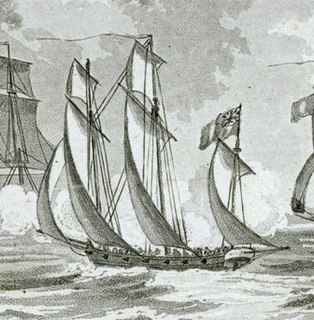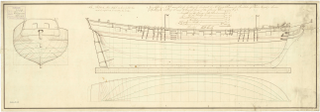Capture, career, and fate
In December 1796, Apollo and Polyphemus were off the Irish coast when they captured the 14-gun French privateer schooner Deux Amis, reportedly of "100 tons" bm and 80 men. [2]
Deux Amis arrived at Cork on 1 January 1797 and was registered on 16 March. Master J. Watson commissioned her in February. She underwent fitting at Portsmouth from May to September 1798. [1]
Master Samuel Willson took command in May 1798. [1] In November Deux Amis captured the Spanish snow African Packet. African Packet was carrying silver, which Willson placed in the hands of the firm of Marsh and Creed, London, for onward transfer to the Registry of the High Court of Admiralty. [3]
Deux Amis wrecked on the night of 23–24 May 1799 on the back of the Isle of Wight; her passengers and crew were saved. She was sailing from Jersey to Portsmouth when on the night of the 23rd she struck a sunken rock at Grange Chine. She had as passengers Lieutenants d'Auvergne and Lemprière, and Matthew Gosset, Viscount of Jersey. [Note 1]
Deux Amis left Jersey on 23 May 1799 and at 3:30 in the morning she hit a rock. Despite efforts to save her, water entered the ship faster than the pumps could remove it. After the passengers left in a boat, Willson decided to run her ashore, which he did. As a result, there were no casualties. While Deux Amis was in distress at sea, local fishing boats came to help; once she ran ashore, the local populace gave priority to plundering rather than rescue. [4] When Captain Green of the North Hants militia heard what was happening, he and his officers sent a strong detachment to enforce order. [5]

HMS Indefatigable was one of the Ardent-class 64-gun third-rate ships-of-the-line designed by Sir Thomas Slade in 1761 for the Royal Navy. She was built as a ship-of-the-line, but most of her active service took place after her conversion to a 44-gun razee frigate. She had a long career under several distinguished commanders, serving throughout the French Revolutionary Wars and the Napoleonic Wars. She took some 27 prizes, alone or in company, and the Admiralty authorised the issue of four clasps to the Naval General Service Medal in 1847 to any surviving members of her crews from the respective actions. She was broken up in 1816.

HMS Babet was a 20-gun sixth-rate post ship of the British Royal Navy. She had previously been a corvette of the French Navy under the name Babet, until her capture in 1794, during the French Revolutionary Wars. She served with the British, capturing several privateers and other vessels, and was at the Battle of Groix. She disappeared in the Caribbean in 1800, presumably having foundered.
HMS Charlotte was a mercantile schooner that Royal Navy hired or chartered in 1796, purchased in 1797 and commissioned in 1798. In her brief military career in the Caribbean she captured two small enemy privateers before she herself fell prey to a French privateer. The British recaptured her a little more than a year later but then broke her up in 1799 rather than recommissioning her.
HMS Fulminante was a cutter belonging to the French Navy that the British captured in 1798, the French recaptured in 1800, and the British re-recaptured three months later. She was wrecked early in 1801.
HMS Port Royal was a 10-gun schooner that the British Royal Navy bought in Jamaica in 1796. The French captured her in 1797 and the British recaptured her later that year, when they renamed her HMS Recovery. She captured three privateers, one in a single-ship action, before the Navy sold her in 1801.

Etna was a French naval Etna-class ship-sloop launched in 1795 that the Royal Navy captured in November 1796. She was taken into service as HMS Aetna and renamed to HMS Cormorant the next year. She captured several merchant vessels and privateers before she was wrecked in 1800 off the coast of Egypt.

HMS Clyde was a Royal Navy Artois-class frigate built at Chatham Dockyard of fir, and launched in 1796. In 1797, she was one of only two ships whose captains were able to maintain some control over their vessels during the Nore mutiny. In 1805, HMS Clyde was dismantled and rebuilt at Woolwich Dockyard; she was relaunched on 23 February 1806. She was ultimately sold in August 1814.

His Majesty's hired armed vessel Aristocrat served the Royal Navy, twice, as a lugger from 1794 to 1798, and as a brig from 1799 to 1801. She served with the Jersey-based Channel Islands flotilla under Commodore Philippe d'Auvergne, Prince of Bouillon. As a lugger she participated in two notable engagements, the second of which won for her crew the Naval General Service Medal, awarded some 50 years later. As a brig, she captured two privateers.
Two vessels have borne the designation, His Majesty's hired armed cutter Lion. The first served during the French Revolutionary Wars, capturing five privateers and several merchant vessels. The second served briefly at the start of the Napoleonic Wars. Both vessels operated in the Channel. The two cutters may have been the same vessel; at this juncture it is impossible to know. French records report that the French captured the second Lion in 1808 and that she served in the French Navy until 1809.

HMS Hound was a brig-sloop of the Royal Navy. She had a short history. After her launch in 1796 she captured two privateers and destroyed a third before she was lost in 1800.

HMS Diligence was the name ship of her class of brig-sloops of the Royal Navy. She was launched in 1795 and lost in 1800. She spent her brief career on the Jamaica station where she captured four armed vessels, one of them after a short engagement, and many small Spanish and French merchant vessels in the Caribbean inter-island and coastal trade.

HMS Redbridge was one of four schooner-rigged gunboats built to an experimental design by Sir Samuel Bentham. Her launch date is unknown, but the Admiralty purchased her in April 1798. She had a short, relatively uneventful career before the French captured her in 1803. The French Navy sold her in January 1814.
The French brig Amarante, was launched in 1793 at Honfleur for the French Navy. The British Royal Navy captured her at the end of 1796 and took her into service as HMS Amaranthe. She captured one French vessel in a single-ship action before she was wrecked near Cape Canaveral, Florida, in 1799.
His Majesty's Hired armed cutter Sandwich served the Royal Navy from 23 May 1798 until the French frigate Créole captured her on 14 June 1799. She then served in the French Navy until the Royal Navy recaptured her on 15 October 1803. The Navy purchased her in 1804 and she served for some months in 1805 as HMS Sandwich before she was sold in Jamaica. During this period she captured three small French privateers in two days.
HM hired armed cutter Flora served the British Royal Navy under contract from 16 August 1794 until a French privateer captured her on 1 December 1798.
HMS Sparrow was launched in 1780, almost surely under another name. She first appears in 1793 in readily accessible records as the privateer cutter Rattler. The British Admiralty hired her and employed her as HM Hired armed cutter Rattler. During this time she was present at the largest naval battle of the French Revolutionary Wars. The Navy purchased her in 1796 for the Royal Navy and renamed her HMS Sparrow. She was sold for breaking up in 1805.

HMS Bonetta was the French privateer Huit Amis, launched at Bordeaux in 1798 that the British Royal Navy captured in May. In her brief naval career she captured a number of small prizes, one of them a 2-gun privateer. Bonetta was wrecked in 1801.

HMS Albacore was launched in 1793 at Rotherhithe. She captured several privateers and a French Navy corvette before she was sold in 1802.
Between 1793 and 1805, five cutters served the British Royal Navy as hired armed vessels under the designation HM hired cutter Rose:
HMS Growler was a Courser-class gun-brig built for the British Royal Navy at Northfleet and launched in 1797 as GB No. 26; she was renamed Growler on 7 August the same year.









